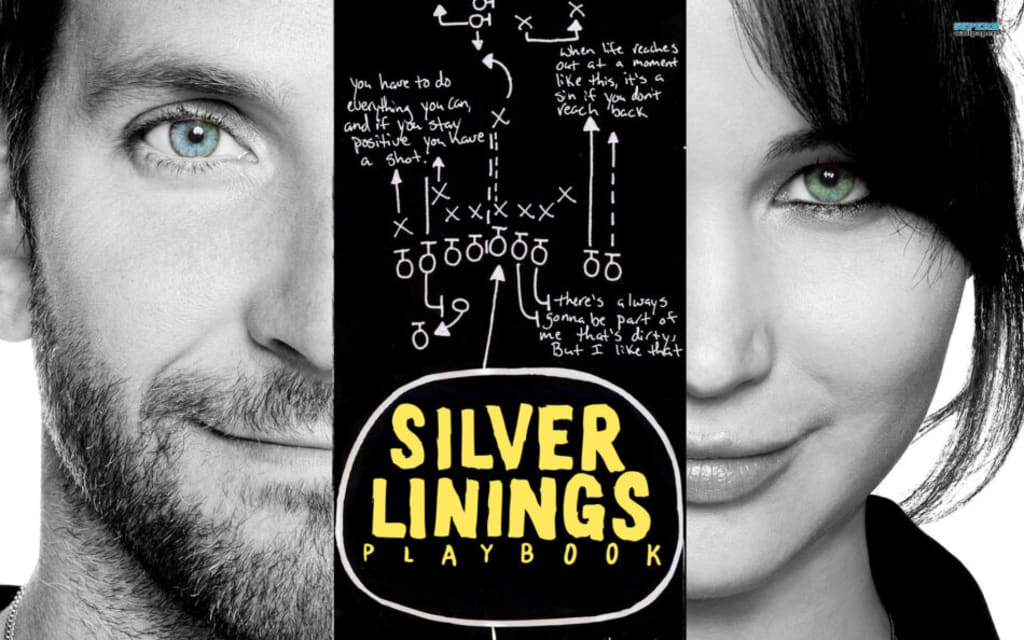Silver Linings Playbook is not a story about how love cures all
It is a story about recovery

Silver Linings Playbook has long been one of my favourite movies. David O'Russel did a genius job of adapting the novel into an explosive screenplay with a huge heart, much like our main characters Pat and Tiffany. Bradley Cooper and Jennifer Lawrence gave performances of a lifetime, earning both Oscar Nominations and a win for J-Law. With O'Russel's direction, the trio went on to work on American Hustle and Joy following the success of Silver Linings Playbook. But upon its' release, many voiced concerns that the movie adds to stigma surrounding mental illness and its' treatment. The narrative structure, culminating in the two main characters falling in love and deciding to be together implies a "happily ever after" that we know is not realistic for anyone, let alone for people suffering from long-term psychiatric conditions. But I'm here to argue that this was not the filmmakers intent. Let's break it all down.
Pat suffers from Bipolar Disorder, and has been basically "white-knuckling" it his whole life until his wife cheats on him. He snaps, almost beats the guy to death and is forced to serve 8 months in a Baltimore mental institution. It is here that he receives his diagnosis of bipolar and is put on some medication, which he usually spits out. He makes some progress in the hospital, deciding to be a positive person, dedicating himself to self-improvement in order to get his wife Nicky back. However, upon leaving, it is clear that he still has a long way to go. He refuses to take meds, his speech and behaviour is still manic, and he's delusional in thinking that Nicky will take him back.
Now let's look at Tiffany. Tiffany's husband, Tommy, has died, she's moved back home with her parents, and she just got fired from her job by sleeping with everyone from the office and accusing her boss of sexual harassment. It's clear she's had problems for a long time, saying she didn't want to have kids with Tommy because she can barely look after herself. She's open about that fact that she's been on meds and that she knows she's "fucked up" and a "big slut". Her behaviour is unpredictable and erratic, and though her diagnosis is never disclosed it is clear that she meets some of the criteria for Borderline Personality Disorder.
The way that these characters are portrayed has been praised by psychiatrists for their accuracy in embodying the speech patterns and behaviours of those that suffer from these psychological conditions. Moreover, their honest dialogue about medications is enlightening to hear as it's emblematic of the way those who take these medications talk about them. They talk about real drugs and their common side-effects, as well as their reasons for stopping meds and being resistant to taking them in future. This is highly relatable to anyone who has ever taken psychoactive medication as we know that things are not as simple as taking medicine and getting better. It can be a huge trial and error process finding the right medications for you, and in the end there's often a trade off where you have to accept some minor side effects in order to treat your condition. Many viewers worried that the characters' behaviour around skipping meds set a bad influence, but we see Pat realise that he has to give medication a chance after hitting his mother and father during an episode. It's implied that this wake up call does the trick and that Pat goes on to take his medication consistently from here on out. This, in combination with regular therapy and the cathartic effect of the dance rehearsals with Tiffany, makes a really positive difference to Pat, and we see that he becomes a more stable person with realistic thoughts by the end of the movie. In the final act, when the pair attend the dance competition, Tiffany by comparison is a mess and Pat acts as a stabalising force, calming her down when she's nervous and holding her to her commitment to performing the dance even after she's hit the bar in complete panic at Nicky's unexpected arrival. I would argue that this actually destigmatises mental health treatments, as we see clearly how much Pat has changed after a couple of months of consistent medication and therapy.
Let's contrast Pats' development with Tiffany's. Tiffany's behaviour remains pretty erratic throughout the entire movie. When we meet her it's clear that she's made some positive changes, she has mostly stopped trying to have sex with lots of strangers, though she does almost slip up a couple of times. Moreover, she embraces her flaws, saying "I may be sloppy and dirty but I like that about myself, along with all the other parts of myself". She acts as a foil for Pat in this scene as he so clearly does not like his flaws and actively strives to beat them with his silver linings playbook. The self-acceptance and forgiveness that Tiffany displays is so important to her recovery and demonstrates that a degree of healing has already taken place. Tiffany's husband, Tommy, died when he drove to Victoria Secret to pick up some lingerie to get something going with Tiffany. She says that she hadn't been into sex because she was feeling depressed and notes that the Victoria Secret box was still in the front seat when he was hit by a car and killed. It's clear when she tells this story that she feels a lot of guilt about this, because she thinks that if she'd just had sex with him he'd still be alive. It's no wonder then, that this trauma led her to become hypersexual in the aftermath of Tommy's death. The fact that she has moved on from this coping mechanism and into self-acceptance and forgiveness is a really positive thing for her, which frees her up to fall in love with Pat and pursue a healthy goal, competing in the dance competition. However, she still refuses to go on medication and does not attend therapy at any point in the movie. She remains erratic right until the end, where we see her running away from Pat, tears streaming down her face. Pat catches up and professes his love and that's the end, all we see after this is a happy scene of them cuddling together with no dialogue before the movie ends. The movie does not claim that Tiffany has magically recovered, but it's clear that some audience members interpreted it this way. But given we have actually seen no evidence that Tiffany has changed or recovered, I would argue that we're supposed to assume that she still has the same problems she's always had. But it is a hopeful ending nonetheless, saying that you can give and receive love no matter your flaws, and showing that it's easier to tackle mental illness when you have a loving support network of people who understand you.
Pat and Tiffany are both flawed people with mental illnesses, but they know how to help and support one another. They're both at different stages of recovery and they will never completely get over their illnesses, but they've learned how to accept and live with their problems and with each other's problems. Yes, it might be a recipe for disaster at times, but this final scene at the end of the movie shows us all of the family and friends that are on hand to support them when they are struggling. They all may be a little eccentric in their own ways, as we all are, but together they muddle through. In this way, the movie shows us that we are not so different from people with mental illnesses. It shows us that recovery is possible, even when it you're entire life seems to have fallen apart. We're all flawed and we all need those around us to challenge us and call us out on our bullshit at times, but we are also all deserving of love, support and acceptance.
But don't take my word for it, if you want to hear an actual psychiatrists' take on the movie check out this great interview with Dr. Steven Schlozman: https://www.vulture.com/2012/12/ask-a-psychiatrist-how-does-silver-linings-playbook-handle-mental-illness.html






Comments
There are no comments for this story
Be the first to respond and start the conversation.